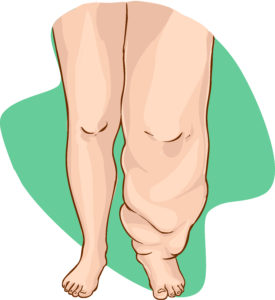EXERCISE AND LYMPHEDEMA
Exercise is an important part of lymphedema self care.
Benefits of exercise include
- Improving blood circulation.
- Increasing the removal of lymph fluid and proteins from swollen tissues during and after exercise.
- Improving joint mobility.
- Increasing muscle strength.
- Helps to maintain healthy body weight.
- Improving overall physical and mental wellness.
During exercise, the contracting leg muscles compress the leg veins and assist the return of venous blood from the lower extremities back to the heart. This brisk return of blood back to the heart helps manage fluid balance in the tissues and prevent leg swelling. Contracting leg muscles also compress superficial lymphatic vessels located between the muscles and the skin and increase the return of lymph fluid from the legs. Under normal conditions, healthy skin provides adequate resistance to the muscle contractions to produce effective compression of the veins and lymphatic vessels. However, in an individual who has lymphedema, the elastic fibers in the skin are often damaged and unable to provide adequate resistance to the muscles, and venous and lymphatic return is not significantly improved. Therefore, patients with lymphedema should wear compression stockings (or compression bandages) during exercise to compensate for the loss of elasticity in the skin and provide the resistance to the muscles necessary to improve venous blood and lymphatic fluid return and maintain reductions in lymphedema.
What exercises should be performed as part of a lymphedema management program? There is no universal agreement on what exercises should be included in an exercise routine. However, it is agreed that individuals should start an exercise program with gentle exercises, and then gradually increase exercise intensity over time. A goal of exercise is to improve return of lymphatic fluid without stressing the impaired lymphatic system. In general, an exercise program could include a combination of:
– Stretching exercises. Stretching of the skin, muscles, and connective tissues in the swollen extremity can preserve joint range of motion, and reduce the feeling of tightness and discomfort, improve flexibility, and facilitate relaxation.
– Strengthening exercises. Strengthening or resistance exercises using weights or resistance bands increase muscle power, and strengthen bone, tendons, and ligaments. A strengthening exercise program should begin with lighter weights or lighter resistance and more repetitions, and should be progressed gradually.
– Aerobic exercise. Benefits of aerobic conditioning exercises include improved muscle strength, cardiovascular conditioning, weight control, and increased return of venous blood and lymphatic fluid. Consider engaging in 20-minutes of aerobic exercise (walking, swimming/water aerobics, stationary bicycle) everyday.
General guidelines. Monitor your swollen extremity during and after exercise for changes in size, shape, firmness, and heaviness. If swelling occurs, you may need to adjust your activity level. Exercise should not cause discomfort or pain. Progress your exercise program gradually and wear your compression garment when exercising. If you have questions or concerns, discuss exercise options with your doctor or lymphedema therapist.

 507-322-6967
507-322-6967